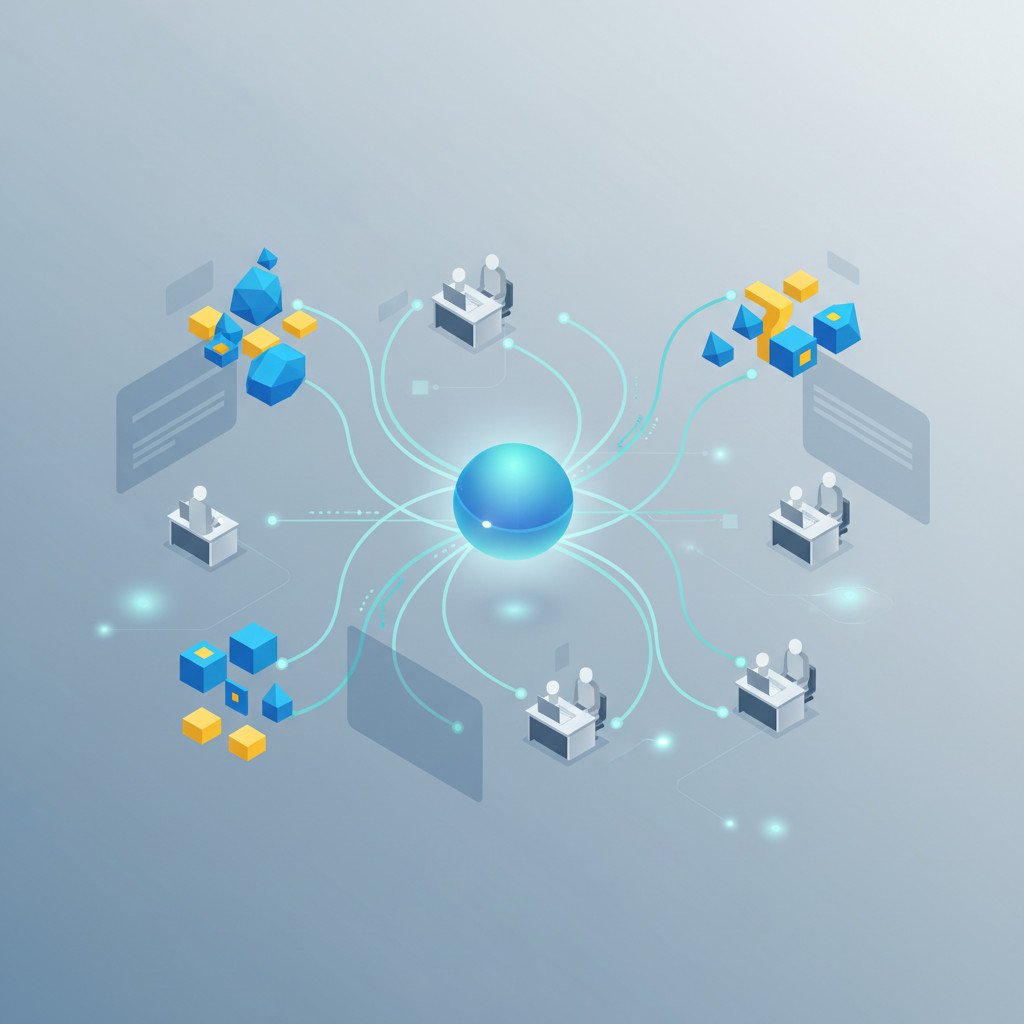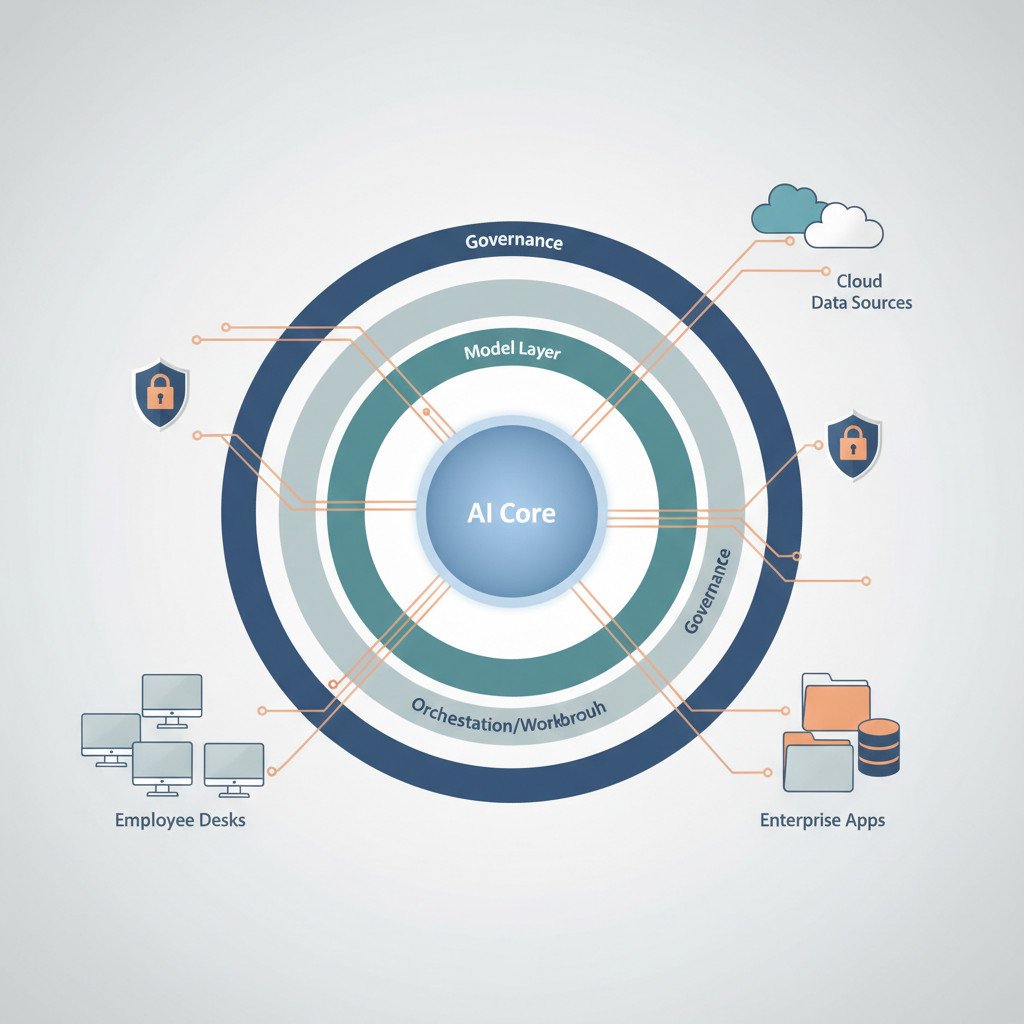Imagine an AI teammate on every desk
Gemini Enterprise brings that idea to life with calm power and bold reach.
Built by Google Cloud, Gemini Enterprise is an agentic platform that bundles Gemini models, first and third party agents, and the Agentspace workbench. It combines a no code workbench, prebuilt taskforce agents, deep data connectors, and enterprise governance into a single system.
Specifically, Gemini models act as the brains. Meanwhile the workbench lets teams build and orchestrate agents without code. Also Model Armor and governance help teams secure, monitor, and audit agent actions.
Why this matters now: companies face fragmented apps, slow workflows, and rising costs. Therefore Gemini Enterprise aims to unify data, tools, and teams so organisations move faster and scale smarter.
Early adopters report tangible productivity gains and reduced agency spend. As a result Gemini Enterprise is shaping how companies deploy AI agents across roles and workflows. This introduction previews the platform’s promise and the practical shifts it enables.
Key Features of Gemini Enterprise
Gemini Enterprise bundles agentic AI, data connectors, and governance into one platform. It pairs Gemini models with an Agentspace workbench to let teams create agents fast. As a result organisations can scale agent deployment across roles.
-
Gemini models and intelligence
- Powered by Gemini models including the Gemini 2.5 Flash Image. These models act as the core reasoning engine. They enable multimodal understanding and fast image reasoning for visual workflows.
-
No code Agentspace workbench
- The workbench offers drag and drop tools and orchestration. Therefore low code and citizen developers can build agents without deep ML expertise.
-
Prebuilt taskforce agents
- Gemini Enterprise ships with specialised agents like Code Assist Agent and Deep Research Agent. Also configurable agents such as Email Ellie accelerate common workflows.
-
Deep data connectors
- Native connectors link Microsoft Teams, Salesforce, Box, Confluence, and Jira to agent workflows. Because agents access live data, they produce contextually accurate outputs.
-
Central governance and Model Armor
- A single governance layer monitors, audits, and secures agents. Model Armor provides content safety and policy enforcement for regulated environments.
-
Open partner ecosystem and agent discovery
- More than one hundred thousand partners extend capabilities. A new agent finder helps customers discover validated partner agents and solutions. For a practitioner view of desk side agents see this Emp0 analysis for real deployments How is Gemini Enterprise turning AI agents into desk side teammates for every employee?.
For implementation guidance, Google Cloud maintains product pages and detailed docs that explain connectors and governance options Gemini Enterprise product page and Gemini Enterprise docs.
Benefits of Using Gemini Enterprise
Gemini Enterprise delivers measurable business results across productivity, cost, and speed. Early adopters report faster content production and lower external spend.
-
Faster output and time savings
- Email Ellie increased content speed by forty percent at an early adopter. Therefore marketing teams can execute more campaigns with the same headcount.
-
Reduced agency and outsourcing costs
- Companies achieved about thirty five percent lower agency dependency. As a result budgets shift from external suppliers to internal platforms.
-
Better data driven decisions
- With connectors to CRM and collaboration tools, agents surface unified context. Consequently analysts and sales teams spend less time searching for answers.
-
Enterprise grade security and compliance
- Governance, audit logs, and Model Armor make the platform suitable for regulated industries. Meanwhile training programs such as Google Skills help organisations upskill staff.
-
Rapid partner enabled innovation
- The GEAR program aims to enable one million developers to build and deploy agents. For technical architects, see a deeper take on secure memory and cipher driven workflows in this Emp0 article Secure Memory Agile AI. Also practical RAG pipeline improvements are discussed in this resource NuMarkdown 8B Thinking.
Taken together, these features and benefits show why Gemini Enterprise aims to be the new front door for AI in the workplace. It combines advanced models, practical tooling, and enterprise controls to unlock real value quickly.

Gemini Enterprise Use Cases
Gemini Enterprise powers real work across industries. Below are concrete examples of how companies deploy agents to solve problems and speed outcomes.
-
Travel and hospitality
- Scenario: Virgin Voyages needed faster customer content and internal automation. Therefore it built over fifty specialised agents across operations and marketing.
- Impact: Email Ellie sped content production by forty percent. As a result marketing saw a twenty eight percent year on year lift in July sales. The fleet of agents also reduced agency dependency and cut external costs.
-
Banking and financial services
- Scenario: Macquarie Bank rolled out Gemini Enterprise to every employee. Because the bank prioritised training, ninety nine percent of staff completed generative AI training.
- Impact: Agents automate routine queries, speed reporting, and surface client context from CRMs. Consequently client teams spend less time on manual lookups and more on advisory work.
-
Marketing, campaigns and sales
- Scenario: Teams use Campaigns Agent and Email Ellie to draft briefs, generate creative, and summarise performance.
- Impact: Faster iterations shorten campaign cycles. Therefore teams run more A B tests and move budgets from agencies to in house efforts.
-
Engineering and product development
- Scenario: Developers deploy Code Assist Agent to accelerate code reviews, suggest tests, and produce documentation.
- Impact: Review turnaround falls and developer velocity rises. As a result releases happen more often and bugs drop.
-
Research, legal and compliance
- Scenario: Deep Research Agent mines documents, identifies precedents, and summarises findings for counsel.
- Impact: Lawyers and analysts get concise briefs in minutes. Therefore expensive research hours fall and audit trails remain intact through governance.
-
IT operations and automation
- Scenario: Native connectors to Microsoft Teams, Salesforce, Box, Confluence, and Jira let agents act on live data.
- Impact: Incident responses and ticket routing speed up. As a result mean time to resolution drops and internal SLAs improve.
Short case snippets show a spread of tangible wins. Some achieve productivity gains, while others reduce cost and improve compliance. Because Gemini Enterprise ties models, workbench tools, and governance, organisations can move from pilots to scaled deployments. In turn, this reduces friction and unlocks value across roles.
For teams planning a rollout, start with high frequency tasks. Then measure time saved and cost shifted. Finally scale via the agent finder and partner ecosystem to broaden impact.
Gemini Enterprise vs Competitors
This quick comparison highlights where Gemini Enterprise stands in the market. It focuses on features, pricing, scalability, ease of use, and security. Use it to shortlist platforms that match your stack.
| Platform | Key features | Pricing (typical) | Scalability | Ease of use | Security and governance | Best fit |
|---|---|---|---|---|---|---|
| Gemini Enterprise | Gemini models plus Agentspace workbench and prebuilt taskforce agents. Deep connectors to Teams, Salesforce, Box, Confluence, Jira. Model Armor and a central governance layer. Open partner ecosystem. | Starts around $30 per seat per month for enterprise tiers; Business starts near $21 per seat. | Built on Google Cloud so it scales globally. GEAR aims to enable millions of developers. | No code workbench and prebuilt agents speed adoption for non developers. | Enterprise audit logs, policy controls, and Model Armor for content safety. | Large enterprises and regulated industries that need integrated agents and governance. |
| Microsoft Copilot (for Microsoft 365) | Native integration across Office apps and Teams. Copilot studio tools for builders. Strong identity and device management. | Per user subscription and licensing required; varies by plan. | Excellent for organizations that run on Microsoft 365 and Azure. | Familiar UI inside Office apps reduces friction for users. | Built on Microsoft compliance and M365 admin controls. | Companies heavily invested in the Microsoft ecosystem. |
| OpenAI (ChatGPT Enterprise and API) | Leading language models, flexible APIs, and plugin support. Strong developer tooling for custom apps. | Usage based API pricing and enterprise seat pricing; costs vary with usage. | Elastic scaling through OpenAI infrastructure. Developers manage orchestration. | Simple chat for end users; custom agent orchestration needs developer work. | Enterprise tier offers data protections and admin controls. | Teams that need powerful models and custom integrations. |
| Anthropic Claude Enterprise | Safety focused models and long context windows. Emphasis on alignment and guardrails. | Enterprise pricing on request. | Designed for enterprise deployments and API scale. | API and simple interfaces; integration work may be required. | Safety and alignment features are a core differentiator. | Organizations prioritizing model safety and alignment. |
| Salesforce Einstein | Deep CRM integration with automation and insights. Works inside Salesforce flow and records. | Bundled into Salesforce licensing and add ons. | Scales within Salesforce clouds and customer data models. | Intuitive for CRM and service teams already using Salesforce. | Governance is handled inside Salesforce platform controls. | Sales and service organizations that rely on Salesforce. |
Match your choice to existing infrastructure, security needs, and developer capacity. Therefore pilot with high frequency tasks. Then measure outcomes and scale what works.
Technical Architecture and Security of Gemini Enterprise
Overview
Gemini Enterprise combines large models, agent orchestration, and enterprise controls. Its design focuses on robustness, data safety, and operational visibility. As a result organisations can deploy agents at scale with confidence.
Core architecture
The platform separates concerns into modular layers. First, Gemini models act as the reasoning layer. Second, the Agentspace workbench handles agent creation and orchestration. Third, connectors link enterprise systems and data sources. Because each layer isolates responsibilities, teams update components without broad downtime.
Data connectors and integration
Native connectors bring data from Microsoft Teams, Salesforce, Box, Confluence, and Jira into agent workflows. Consequently agents operate on live context rather than stale snapshots. In addition, secure APIs and token-based auth protect data in motion. For platform details see the Gemini Enterprise product page.
Governance and Model Armor
A central governance layer enforces policies across agents. Therefore administrators set allowed sources, approve agents, and inspect activity. Model Armor adds content safety checks and inline guardrails. As a result organisations can balance utility and risk while keeping audit trails.
Compliance and operational security
Gemini Enterprise runs on Google Cloud security infrastructure. It inherits identity controls, encryption at rest and in transit, and region controls. In addition, logging and SIEM integration help teams detect anomalies quickly. For a broader view of Google Cloud security capabilities visit Google Cloud security capabilities.
Resilience and scalability
Built on Google Cloud, the platform scales with demand. Architectures use autoscaling inference fleets and model sharding for heavy workloads. Moreover redundancy and multi region options reduce single points of failure. Therefore enterprises can meet strict uptime SLAs.
Deployment, control and developer tooling
Administrators control agent lifecycles through the workbench. Meanwhile the GEAR program and partner ecosystem provide prevalidated integrations. Because developer tools support CI CD and testing, teams can iterate agents safely and reproducibly.
Taken together, Gemini Enterprise pairs advanced model capabilities with enterprise controls. Consequently organisations gain powerful automation while retaining governance, security, and operational resilience.

How to Get Started with Gemini Enterprise
Getting started requires clear goals and small bets. First, pick a high frequency task that drains time. Then test an agent to prove value quickly.
Quickstart checklist
- Define a pilot objective and success metrics such as time saved or cost reduced.
- Identify the data sources you need and confirm connector availability.
- Set governance guardrails up front using Model Armor and audit logs.
- Choose a stakeholder sponsor and a cross functional pilot team.
Step by step
- Align on the use case
- Focus on repeatable work with measurable outcomes. For example, drafting marketing emails or routing IT incidents. Because these tasks repeat often, agents deliver clear ROI.
- Prepare data and access
- Audit sources like CRM, Confluence, or Jira. Next, configure connectors and token based authentication. This ensures agents use live context and maintain data security.
- Build the agent
- Use the Agentspace no code workbench to prototype fast. Also reuse prebuilt taskforce agents where possible to shorten time to value.
- Secure and govern
- Enable policy controls and approve agent permissions. Meanwhile set logging and alerting so teams can audit behaviors in real time.
- Train people and measure
- Run short training sessions and provide playbooks. Then gather metrics weekly and iterate on prompts and orchestration.
- Scale with partners and GEAR
- Once the pilot succeeds, expand via the agent finder and partner ecosystem. Moreover consider the GEAR developer program to accelerate internal builds.
Tips and best practices
- Start small and iterate quickly.
- Prioritise high volume, low risk tasks first.
- Measure impact, because data drives further investment.
- Combine training with governance to foster adoption safely.
For official setup steps and admin guides, visit the Gemini Enterprise documentation on Google Cloud.
Future Trends and Innovations for Gemini Enterprise
Gemini Enterprise will shape how organisations work with agents. Over the next years, expect agents to move from pilots to daily teammates. Because models get faster and cheaper, adoption will accelerate.
Key trends to watch
- Agent ubiquity on the desktop and workflow surfaces
- Teams will deploy specialised agents for sales, legal, and ops. As a result workflows shrink and cycle time falls.
- Multimodal reasoning and visual workflows
- Gemini models, including future Flash Image variants, will handle documents and images faster. Therefore visual automation will expand into design, quality checks, and inspections.
- Data fabric and real-time connectors
- Organisations will build enterprise graphs linking CRM, collaboration, and knowledge stores. Consequently agents will deliver contextual answers with live data.
- Governance that scales with speed
- Model Armor will evolve into real-time policy enforcement and risk scoring. Meanwhile audit trails become standard for regulated firms.
- Developer ecosystem and marketplace growth
- The GEAR program will create many agent builders. In addition an agent marketplace will let firms buy validated vertical agents.
- Hybrid deployment and secure memory
- Expect more on-prem and edge inference options for sensitive workloads. Also secure memory patterns will let agents personalise without leaking secrets.
- Human centered augmentation
- Finally, agents will amplify human skills. However cultural change matters as much as technology.
Prepare by piloting high frequency tasks. Then scale with governance and skill programs. As a result Gemini Enterprise will not only automate work. It will change how organisations think about teams and productivity.
Conclusion: Why Gemini Enterprise Matters
Gemini Enterprise unifies powerful Gemini models, an Agentspace workbench, and enterprise governance into one platform. As a result organisations can automate repeatable work and scale agents across teams. Therefore the platform delivers measurable gains in speed, cost, and compliance.
Early adopters show clear benefits. For example, Virgin Voyages sped content production and lifted sales. Similarly, Macquarie Bank trained staff and rolled agents company wide. Because these wins are practical, leaders should treat Gemini Enterprise as a strategic platform rather than a niche experiment.
EMP0 is a US based AI and automation company that specialises in sales and marketing automation solutions. Moreover EMP0 builds AI powered growth systems that mirror the practical automation patterns found in Gemini Enterprise. EMP0 online presence details
- Website: emp0.com
- Blog: articles.emp0.com
- Twitter/X: @Emp0_com
- Medium: medium.com/@jharilela
- n8n: n8n.io/creators/jay-emp0
Start with a focused pilot, then scale with governance and training. Finally measure outcomes and iterate quickly. As a result, your organisation can turn agents into reliable desk side teammates and unlock sustained productivity.

